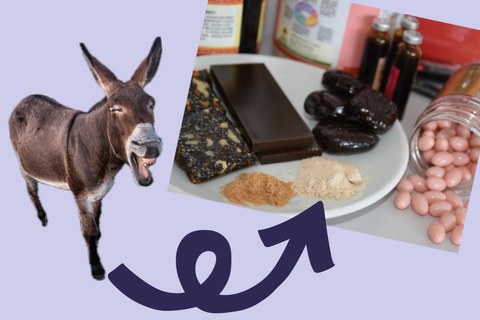Feb 17, 2024
Animals and Money: Donkey Skins for Eternal Youth

Donkeys are increasingly valuable, as their skin is used to produce a gel, "Ejiao". Ejiao is popular in China for its medical and rejuvenating effects. More and more donkeys are killed across the globe to meet China’s demand, which endangers the global donkey population. The donkey skin trade also poses economic and social problems, especially for rural communities in Africa, where living donkeys are important rural workers.
More and more donkeys are killed across the globe to meet China’s demand for their skins in the production of Ejiao. Ejiao is a hard gel used in Traditional Chinese Medicine. The trade is profitable to the people producing Ejiao but detrimental to donkey populations and their owners. The animals are needed to support rural communities. Especially in African countries the loss of equine populations could lead to economic ruin for rural communities.
Traditional Chinese medicine and its use of animal derivates dates back over 5000 years1, 2. One such animal derivative to produce Ejiao is donkey skins. Ejiao is a Gelatine substance used in various health and beauty products for its medicinal and rejuvenating benefits3. Over the last decades, the demand for Ejiao has increased exponentially, possibly because people are getting older and have more money to spend due to economic growth3. The increasing demand makes donkeys very valuable, however, the donkey skin trade poses economic and social problems. From 2013 to 2016, Ejiao production in China has increased by 20%, from 3200 tonnes to 5600 tonnes annually4. To keep up with this demand, roughly 4,480,000 donkeys had to be killed every year, since one donkey hide can produce about 1.25kg of Ejiao5. Up to 20% of donkeys die before they even reach the slaughterhouse, as they are transported under precarious conditions4. Therefore, the real number of demanded donkeys is likely even higher than 4.48 million. Only 1.8 million of those donkeys are domestically sourced in China itself. The rising demand of this scale puts China's and consecutively the world’s donkey population at risk4, 6, 7. The calculations show that around 2.5 million donkeys must be imported from somewhere else. This creates a lucrative market. Sub-Saharan Africa exports about 1.8 million donkey hides to China annually8. In many African countries like Kenya, Chinese-operated slaughterhouses kill hundreds of donkeys daily9, 4. However, killing all these donkeys poses several problems for the local people. In many low- and middle-income countries, donkeys are relied upon by the rural population for agriculture, transport and construction10, 6, 11. In Ghana, owning a donkey is estimated to save an adult about 5 hours of labour a week, children 10 hours12. The livelihood of approximately 158 Million people in Africa alone depend on them. The high demand for donkeys has opened up the market for middlemen. Middlemen have connections to the Chinese trade and can sell the donkeys to Chinese operated slaughterhouses. Selling a donkey to a middleman gives the individual a momentary money flush, but in the long run it could mean financial ruin. If farmers are unwilling to sell, donkeys are often even stolen from them4. Smallholder farmers lose an average of $109.73 per month for every donkey they lose through sale or theft13. The income generated by the help of the donkeys enables owners to invest in savings schemes and contributing to building stronger economies within their communities4. Without them, more hands are needed to make up for the loss. This often means that children are unable to attend school, continuing the cycle of poverty. The result is that millions of dollars are potentially being taken each year from the communities that can least afford to lose them4. Because of the negative impact on their citizens, many African countries have banned the trade; Botswana, Uganda, Tanzania, Niger, Ghana, Gambia, Ethiopia, Burkina Faso, Mali, and Senegal all made the export of donkey hides illegal14. The trade doesn’t only negatively affect individuals dependent on equine support: the demand for donkey hide is driving donkeys to extinction. Intensive farming of donkeys is also difficult as the species is not well-suited for it. Donkeys have complex nutritional needs, a long gestation period and specific social needs16, 17.
It could take around 15-20 year to create a sustainable Chinese farming system able to meet their demand for hides without relying on other countries3. In those years, the damage to the world's donkey population and those that rely on the animals will already be irreparable. The shrinking donkey population is even affecting the end of the supply chain. Ejiao companies, have reported dropping revenues since 2018, due to shortage of donkey skins. They also predict their profits to decrease further in the future4.
This essay shows that while killing donkeys to make Ejiao of their skin is profitable at first, it is unsustainable and damaging in the long run. The problem presented in this essay is not an easy one to fix. „While demand exists, so will the route to fuel it“15. Closing down slaughterhouses and legislating the trade of donkey hides to China has shown limited success. Efforts to control the resulting illegal market are needed.
Global awareness is therefore of the greatest importance. Partnership across NGOs, agencies and government remains essential not only in the countries currently negatively affected by the trade, but in western countries as well, since the diminishing donkey population is a growing problem. Further research also needs to be conducted to find sustainable alternatives to Ejiao. A promising lead is the Chinese cellular agriculture industry; advances are being made in the production of artificially grown, donkey-derived collagen 4. This could mean a more sustainable, controllable source of Ejiao.
Cosima Sagurna
Issue 15 (PDF)
